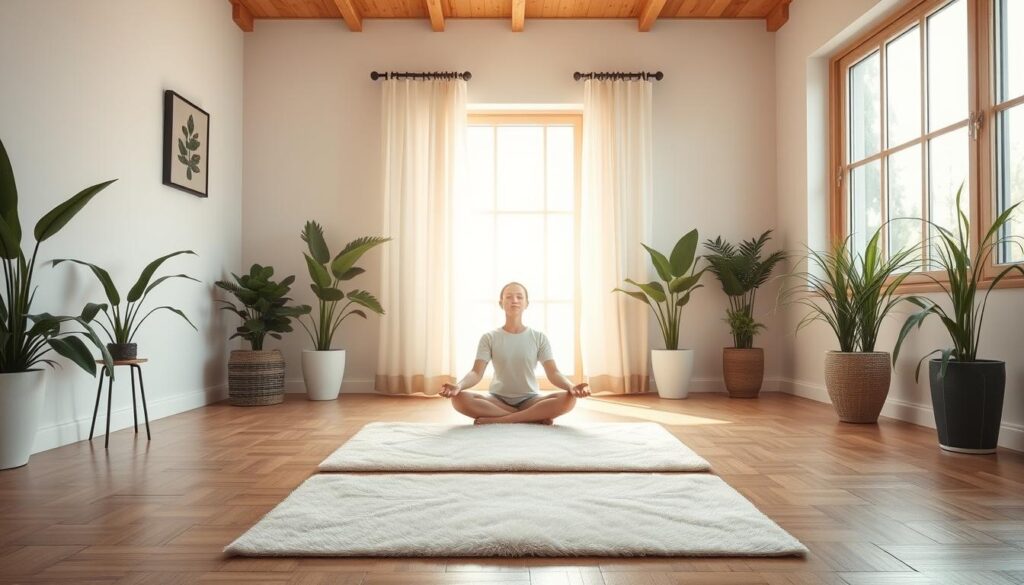“The Roots of Peace are in the Heart” – Rumi
In today’s fast-paced world, finding inner peace is crucial. Guided meditations are a strong way to calm your mind and soothe your soul. Melody Hansen, a meditation and yoga teacher, will lead a 30-minute session. She will help you open your heart and connect with your inner divine.
This session combines breathing exercises, visualizing a peaceful lotus flower, and reciting the “Hong Sau” mantra. It’s perfect for those looking to reduce stress, connect with themselves, or just find a moment of calm. These meditations can help you achieve the balance and peace you seek.
Key Takeaways
- Guided meditations offer a powerful tool for reducing stress and cultivating inner peace
- The practice includes breathing exercises, visualization, and mantra recitation to promote mindfulness
- Consistent meditation practice can gradually enhance self-awareness and emotional well-being
- Meditation helps activate the parasympathetic nervous system, fostering calmness and anxiety relief
- Guided meditations can assist in letting go of what you can’t control, promoting acceptance and inner peace
Understanding the Power of Inner Balance and Meditation
Meditation is a powerful tool for finding inner peace. It has been proven to reduce stress and improve emotional health. By practicing meditation, you can stay calm and focused in everyday life.
The Science Behind Meditation and Peace
Many studies show meditation’s positive effects on our minds and bodies. It can lower heart rate and blood pressure, leading to deep relaxation. This change helps reduce anxiety and pain, improving our emotional state.
How Inner Balance Affects Daily Life
Meditation helps you handle life’s ups and downs better. It brings balance, allowing you to face challenges with clarity and kindness. You’ll make wiser choices and build stronger relationships, staying calm and centered.
The Mind-Body Connection
Meditation connects our minds and bodies. It teaches us to be present through breathing and body awareness. This approach boosts sleep, energy, and overall well-being, making life more joyful and meaningful.

“Meditation is not about becoming a different person, a new person, or even a better person. It’s about training in awareness and learning to be present.” – Jon Kabat-Zinn
Getting Started with Guided Meditations for Inner Peace
If you’re new to meditation, guided meditations are a great way to start. They offer support and direction to help you meditate regularly. This can lead to inner balance and calm.
Start by sitting comfortably with your erect spine and relaxed shoulders. Take deep breaths to calm your body and mind. Many guided meditation apps and videos can guide you through these steps.
Meditation teacher Steven Webb says a typical guided meditation session is about 15 minutes long. These sessions focus on breathing to relax and concentrate. You’ll learn to release tension in your body.
| Meditation Technique | Duration | Focus |
|---|---|---|
| Guided Meditation | 15 minutes | Breathing, Relaxation, Mantras |
Adding guided meditation to your routine helps you grow in meditation skills. These relaxation techniques can quickly ease stress and anxiety. They create a mental space for calm whenever you need it.

“Meditation is the journey of the self, to the self, through the self.” – Bhagavad Gita
Start small and be consistent to see meditation’s benefits. Regular practice can bring inner peace and balance into your life.
Creating Your Perfect Meditation Space
Creating a dedicated meditation space is key for inner peace and balance. A serene spot in your home can inspire and support your meditation. We’ll look at the must-haves, meditation props, and how to set the mood for your meditation haven.
Essential Elements for a Peaceful Environment
Your meditation space needs to be quiet and free from distractions. Think about comfy seating, soft lights, and little visual noise. Adding plants, stones, or calming art can make it even more peaceful.
- Comfortable seating (cushions, mats, or chairs)
- Soft, indirect lighting (candles, lamps, or natural light)
- Decluttered and clean surroundings
- Nature-inspired décor (plants, stones, or artwork)
Recommended Tools and Props
Choose meditation props that make your practice better. Good cushions, blankets, or a meditation chair are key for comfort. Adding soothing scents like essential oils or incense can also help.
- Meditation cushions or mats
- Cozy blankets or shawls
- Meditation chair or bench
- Diffuser for essential oils
- Incense or candles
Setting the Right Atmosphere
To finish your meditation space, create an atmosphere that feels right to you. Pick calming colors, let in natural light, and add grounding elements like rugs or mats. Your meditation space should be a special place to escape and explore your inner self.
“Your meditation space should be a sanctuary, a haven where you can disconnect from the outside world and dive deeper into your inner world.”
Basic Breathing Techniques for Meditation
Breathing exercises are key to a good meditation practice. They help you find inner peace and calm. Let’s look at some basic breathing techniques for mindful breathing.
Beginners should start with five deep breaths. Breathe in slowly through your nose, feeling your belly rise. Then, breathe out fully through your mouth. This simple act can calm your mind and get you ready for meditation.
The 3-6 breathing exercise is great for reducing anxiety. Breathe in for 3 counts, hold for a moment, and then breathe out for 6 counts. You can try different counts to find what works best for you.
The box breathing method is another good one. Breathe in for 4 counts, hold for 4 counts, breathe out for 4 counts, and then hold again for 4 counts. This method helps you feel balanced and in control.
Alternate nostril breathing balances your brain’s hemispheres. Close one nostril with your finger, breathe in through the other, then switch and breathe out. Keep switching sides and breathing in a rhythmic way.
Adding these breathing exercises to your daily life can make your mindful breathing practice stronger. Whether it’s a quick break or a dedicated meditation time, your breath can keep you grounded in the present.
“Breathing in, I calm my body. Breathing out, I smile. Dwelling in the present moment, I know this is a wonderful moment.” – Thich Nhat Hanh
The secret to breathing exercises is regular practice. Start small, try different methods, and let your breath lead you to inner peace and balance.
The Hong Sau Technique: A Path to Tranquility
In meditation, the Hong Sau technique is a standout for inner peace and focus. It comes from Raja Yoga and leads to self-discovery and spiritual growth.
Steps to Practice Hong Sau
- Find a comfy seat, on the floor or in a chair, and close your eyes.
- Focus on your breath, letting it guide you inward.
- Repeat “Hong” on inhale and “Sau” on exhale. These words mean “I am Spirit,” connecting you to your essence.
- When your mind strays, return to the Hong Sau mantra and your breath.
Benefits and Expected Outcomes
The Hong Sau technique benefits body and mind. It improves concentration, brings inner peace, and deepens spiritual connection. Regular practice can also increase focus, emotional balance, and self-awareness.
Common Challenges and Solutions
While powerful, the Hong Sau technique faces challenges. A common one is a wandering mind. Gently refocus on your breath and mantra without judgment. With time and effort, you’ll overcome these obstacles and deepen your meditation.
“The Hong-Sau technique of concentration is one of the most effective methods for calming the conscious mind and withdrawing the senses from external distractions.” – Paramahansa Yogananda
The Hong Sau technique is a deep path to tranquility. It opens the door to your inner self. By practicing it, you’ll discover yourself, improve focus, emotional balance, and spiritual connection, enriching your life.
Connecting with Your Heart Center Through Meditation
Discover the power of heart-centered meditation. It deepens your emotional and spiritual connection. By focusing on the heart chakra, you start a journey of self-discovery and emotional healing.
This meditation combines breathwork, visualization, and affirmations. Find a quiet spot without distractions. Relax your body and calm your mind with deep breaths.
Picture a green lotus flower blooming in your chest. It symbolizes the heart chakra. See this flower spreading warmth and love through your body with each breath.
Repeat affirmations that mean something to you. Say things like “I am worthy of love” or “I am a vessel of kindness.” Let these words fill your heart with love and self-worth.
Imagine sharing this warm light from your heart with others. Feel love and kindness flowing out, beyond your own being.
Regular heart-centered meditation brings peace and self-acceptance. It helps you grow spiritually. Whenever you need emotional support, return to your heart center for guidance.
Visualization Exercises for Deep Inner Peace
Start a journey of self-discovery and inner calm with visualization exercises. These mental practices can lead to deep relaxation, balance, and personal insights.
The Lotus Flower Meditation
Picture a beautiful lotus flower blooming inside you. See its delicate petals opening, showing a bright golden center. As you breathe, feel the lotus grow, symbolizing your spiritual growth.
Let the calm image fill your heart and mind. It brings peace and wholeness.
Light and Energy Visualizations
- See a warm, healing light coming from your heart, spreading to all your cells.
- Picture a glowing ball of energy at your solar plexus, full of life and strength.
- Imagine sparkling, restorative energy flowing down from your head, filling you.
Nature-Based Mental Imagery
Imagine yourself in a peaceful forest. You’re surrounded by tall trees, a flowing brook, and leaves rustling. Feel the sun’s warmth and the cool breeze on your face.
Let the forest’s sights, sounds, and feelings calm you. It brings deep peace and balance.
These visualization exercises can make your meditation better. They help find deep inner peace and growth. Try these techniques and see how powerful your mind can be.
Incorporating Mantras and Affirmations
Discover the power of meditation mantras and positive affirmations for inner peace. These spiritual practices change your thoughts, help you accept yourself, and find your purpose.
Mantras are special sounds that improve your overall well-being. They balance your body, mind, and emotions. For example, “Om” aligns your chakras and connects you to your true self. Chanting “Om Shanti Shanti Shanti” or “Lokah Samastah Sukhino Bhavantu” calms your mind and spreads positivity.
Affirmations are strong statements that fight negative thoughts and boost your inner strength. Saying things like “Though the winds of difficulties howl around me, I stand forever calmly at the center of life’s storms” makes you strong and peaceful, even when things get tough.
“Mantras and affirmations are not mere words – they are tools for transformation, unlocking the door to your highest potential and deepest peace.” – Melody Hansen, Holistic Wellness Educator
Adding these practices to your daily life can change you deeply. Whether you chant mantras during meditation or write down your favorite affirmations, keep going. Be patient, consistent, and open to the power of these ancient wisdom tools.
Explore a world of meditation mantras and positive affirmations that match your journey to inner peace. See these spiritual practices as friends on your path to well-being and self-discovery.
Developing a Consistent Meditation Practice
Creating a regular meditation habit is key to experiencing its deep benefits. By setting up a routine and tracking your progress, you can beat common hurdles. This habit of mindfulness will make your daily life richer.
Creating a Sustainable Routine
Begin with just three minutes of meditation each day. As you get used to it, you can increase the time. Remember, it’s the regularity that matters, not how long you meditate. Guided meditations can help by offering a structured path.
Tracking Your Progress
Keeping an eye on your meditation journey can really motivate you. Use apps or trackers to see how you’re improving. Celebrate every small win, like better focus or less stress, to keep you going.
Overcoming Practice Obstacles
Every journey has its bumps, and meditation is no different. Time issues or trouble focusing can be solved with patience and persistence. Find what works best for you to enjoy and benefit from meditation more.
Be kind to yourself and open to trying new things in your meditation practice. With a steady routine, tracking your growth, and facing challenges head-on, you’ll find meditation’s true power. You’ll gain lasting peace and balance.
| Metric | Percentage |
|---|---|
| Increase in feeling gratitude and embracing slow living after starting a consistent meditation practice | 82% |
| Individuals who reported reduction in stress levels through meditation | 75% |
| Individuals who found guided meditations helpful compared to those who practiced without guidance | 68% |
| Likelihood of meditation becoming a sustainable habit when integrated into daily routines | 90% |
“Consistency is more important than duration in meditation practice, highlighting the significance of maintaining a routine.”
Conclusion
Guided meditations for inner peace can change your life. They help you find balance and harmony every day. By using breath awareness, visualization, and heart-centered practices, you can feel calm and centered.
Regular meditation can make you less stressed and more emotionally stable. It also helps you connect with your inner self more deeply.
Keep moving towards inner peace and balanced living. Let the benefits of meditation guide you to discover yourself more. By taking time for mindful reflection, you’ll find your true self and the peace within.
Start this journey and see how inner peace techniques can improve your life. They bring harmony, fulfillment, and joy. Trust the process and let your inner light shine, making your life richer.
FAQ
What are the benefits of guided meditations for inner peace?
Guided meditations are great for finding inner peace and balance. They help reduce stress and promote emotional balance. This is key for dealing with daily life challenges.
They keep you calm and centered, even when things get tough.
How can beginners start with guided meditation?
Beginners can start with simple meditations. Focus on breath awareness and body relaxation. Guided meditation apps or videos can help.
They offer structure and support for newbies. This helps start a regular meditation routine.
What elements should be included in a meditation space?
A meditation space should be quiet and peaceful. It should have comfy seating and soft lighting. Try to keep distractions to a minimum.
Tools like meditation cushions, blankets, and calming scents can help. They create a sacred space for reflection.
What are some basic breathing techniques for meditation?
Basic techniques include measured breathing. Inhale and exhale for counts of six. You can also observe your natural breath rhythm.
These practices help the mind and breath flow together. They promote relaxation and awareness in the present moment.
What is the Hong Sau technique and how does it benefit meditation?
The Hong Sau technique involves repeating “Hong” on inhale and “Sau” on exhale. It means “I am Spirit.” This improves concentration and brings inner peace.
It also deepens your spiritual connection.
How can heart-centered meditation help with emotional healing and spiritual growth?
Heart-centered meditation opens the heart chakra. It cultivates love and compassion. Techniques include visualizing a lotus flower or recalling joyful moments.
It aims to heal emotions and deepen spiritual connection.
What are some effective visualization exercises for deep inner peace?
Visualization exercises enhance meditation and promote inner peace. Imagine a lotus blooming at the heart center or healing light flowing through your body.
Visualizing peaceful landscapes can also help.
How can mantras and affirmations be incorporated into meditation practice?
Mantras and affirmations are powerful in meditation. They reinforce inner strength and peace. Use mantras like “Thou art my life, Thou art my love” or affirmations like “I stand calmly at life’s storms.”
How can one develop a consistent meditation practice?
To develop a consistent practice, create a routine that fits your life. Tracking progress helps stay motivated. Overcome obstacles like time or focus issues with patience and persistence.
Adjust your techniques as needed to keep growing.




























































